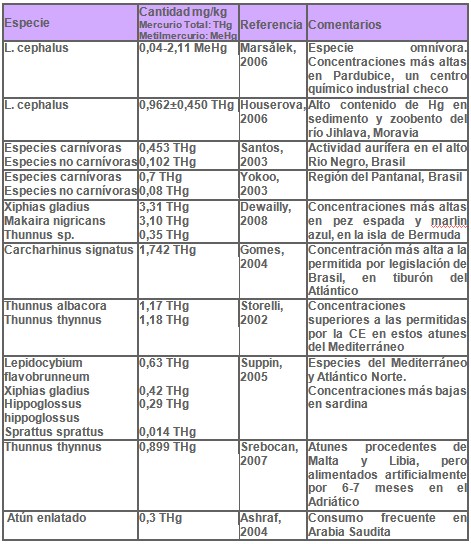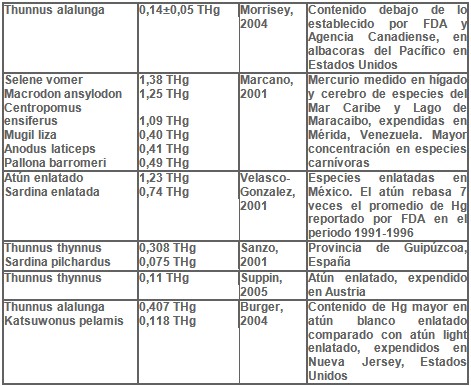Consumo de pescado y exposicion al metilmercurio. Riesgos y beneficios durante el embarazo .8
• Niveles de contaminantes tienen que ser monitoreados en otras especies marinas como los mariscos [Guldner, 2007].
• Una potencial interacción selenio-mercurio debe ser ampliamente investigada [Mozaffarian, 2006].
• Explorar la relación entre el consumo de pescado u otros productos marinos durante el embarazo y el desarrollo neurológico en niños [Méndez, 2008].
• Los mayores efectos según el sexo, en animales de experimentación a la exposición de metilmercurio (roedores machos) han de ser clarificados [Vahter, 2006].
• La posible interacción entre diferentes tóxicos como metilmercurio y policlorobifenilos (PCB) y el riesgo de sus efectos en el neurodesarrollo necesita conocerse mejor [Johansson, 2007].
• El potencial efecto de las frutas del Amazonas, para contrarrestar la toxicidad del mercurio, merece mayor interés [Passos, 2008].
• El monitoreo de mercurio en atún enlatado es necesario, especialmente en los países productores [Burger, 2004].
• Para dilucidar la neurotoxicidad del metilmercurio y los policlorobifenilos (PCB), deben considerarse otros factores según la región, como lo puede ser el contenido de cadmio en el arroz japonés [Nakai, 2002].
• La razón bioquímica de la toxicidad inducida por el metilmercurio aún no es bien entendida y ha de analizarse [Faustman, 2002].
TABLA 1. CONTENIDO DE MERCURIO EN PESCADO


FUENTE: Datos compilados por Luis Caballero 2010
Referencias:
1. Agreda O, Pieters M, Seijas D. Niveles basales de mercurio en orina en escolares del Municipio San Diego, Edo. Carabobo. Gac Méd Caracas 2008; 116(3):212-218
2. Arnold S, Lynn T, Verbrugge L, Middaugh J. Human biomonitoring to optimize fish consumption advice: Reducing uncertainty when evaluating benefits and risks. American Journal of Public Health 2005; 95(3): 393-397
3. Ashraf W, Seddigi Z, Abulkibash A, Khalid M. Levels of selected metals in canned fish consumed in Kingdom of Saudi Arabia. Environmental Monitoring and Assessment 2006; 117(1-3):271-279
4. Ashraf W. Levels of selected heavy metals in tuna fish. The Arabian Journal for Science and Engineering 2006; 31(1A):89-92
5. Ask K, Vahter M, Berglund B, Nikiasson B, Blennow M, Sandborgh-Englund G. Transport of methylmercury and inorganic mercury to the fetus and breast-fed infant. Environmental Health Perspectives 2005; 113(10):1381-1385
6. Ask K, Vahter M, Peterson-Grawé K, Glynn A, Cnattingius S, Darnerud P, Atuma S, Aune M, Becker W, Berglund M. Methyl mercury and inorganic mercury in Swedish pregnant women and in cord blood: Influence of fish consumption. Environmental Health Perspectives 2003; 11(4):637-641
7. Benefice E, Luna S, Lopez R. A nutritional dilemma: fish consumption, mercury exposure and growth of children in Amazonian Bolivia. International Journal of Environmental Health Research 2008; 18(6):415-427
8. Bowerman W, Evans E, Giesy J, Postupalsky S. Using feathers to assess risk of mercury and selenium to bald eagle reproduction in the Great Lakes Region. Arch Environ Contam Toxicol 1994; 27: 294-298
9. Budtz-Jørgensen E, Grandjean P, Weihe P. Separation of risks and benefits of seafood intake. Environmental Health Perspectives 2007; 115(3):323-327
10. Burger J, Gochfeld M, Mercury in canned tuna: white versus light and temporal variation. Environmental Research 2004; 96:239-249
11. Caballero L. Excreción urinaria de yodo (yoduria) en escolares de comunidades indígenas de la cuenca del Río Orinoco en Venezuela. Revista Electrónica Portales Médicos 2008; 3(5)
12. Choi A, Cordier S, Weihe P, Grandjean P. Negative confounding in the evaluation of toxicity: The case of methylmercury in fish and seafood. Crit Rev Toxicol. 2008; 38(10):877-893
13. Cooke C, Balcom P, Biester H, Wolfe A. Over three millennia of mercury pollution in the Peruvian Andes. Proceedings of the National Academy of Sciences 2009; 106(22):8830-8834
14. Davidson P, Myers G, Cox C, Axtell C, Shamlaye C, Sloane-Reeves J, Cernichiari E, Needham L, Choi A, Wang Y, Berlin M, Clarkson T. Effects of prenatal and postnatal methylmercury exposure from fish consumption on neurodevelopment outcomes at 66 months of age in the Seychelles Child Development Study. JAMA 1998; 280(8):701-707
15. DesGranges J, Rodrigue J, Laperle M. Mercury accumulation and biomagnification in ospreys (Pandion haliaetus) in the James Bay and Hudson Bay regions of Quebec. Arch Environ Contam Toxicol 1998; 35: 330-341
16. Dewailly É, Rouja P. Balancing the risks and benefits of local fish consumption in Bermuda. Unité de recherché en santé publique du CHUL (CHUK)Québec, Canada/ Department of Conservation Services-Government of Bermuda. 2008
17. Dorea J. Fish are central in the diet of Amazonian riparians: should we worry about their mercury concentrations? Environmental Research 2003; 92:232-244